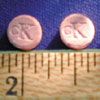Ecstasy: Nothing for Aging Adults to Rave About
In the late 1980s, "club drugs" were typically limited to the so-called rave/techno subculture.1 More recently, studies have shown the growing appeal of 3,4-methylenedioxymethamphetamine (MDMA), or ecstasy to middle-aged and older adults.

Figure 1

Figure 2

Figure 3

Figure 4

Figure 5
In the late 1980s, "club drugs" were typically limited to the so-called rave/techno subculture.1 More recently, studies have shown the growing appeal of 3,4-methylenedioxymethamphetamine (MDMA), or ecstasy (Figures 1-5), to middle-aged and older adults.2
Even when the use of ecstasy was confined mostly to adolescents and young adults, the drug had disturbing adverse effects. MDMA (taken with or without other drugs) has been associated with hyperthermia, rhabdomyolysis, hypo-osmolality, liver failure, metabolic acidemia, psychosis, pneumomediastinum, coronary spasm and ischemia, and death (a summary from a growing list).3-5 If MDMA is dangerous in a young, presumably healthy population, what complications might be expected with expanding use in older adults?
EVIDENCE OF COGNITIVE DEFICITS
A Dutch prospective cohort study focused on a more recently recognized complication of ecstasy use: a decline in memory.6 Fifty-eight "new" ecstasy users were studied over a period of about 11 months. They were compared with 60 non-ecstasy users who were matched for age, gender, intelligence, and other substance exposure, including marijuana. This cohort represented "younger" users; it did not include middle-aged and older users.
The ecstasy users scored lower than the controls on immediate and delayed verbal recall and recognition, although they still fell within the normal range. This memory deficit occurred even with low-dose and short-lived ingestions of MDMA. These findings are consistent with ecstasy's proposed "target areas" in the temporal and hippocampal brain regions. The authors were candid about numerous study limitations (including age), but they emphasized that ecstasy has the potential to cause serious complications.
MOVING INTO THE MAINSTREAM
Subcultural phenomena-in this instance, drug use-can permeate the mainstream culture over time.1 Marijuana initially was a staple of the beat and hippie subcultures, but later cannabis became an issue even for a presidential candidate, who admitted to smoking but not to inhaling! Cocaine use began in the jazz subculture of the 1920s; today it is a mainstream drug of choice. Many people view ecstasy as a safer alternative to cocaine, and this can be a fatal misconception.
So, the next time you see a 40-year-old patient who shows signs of ecstasy use, including memory problems of recent onset, remember that this drug is not just for young "ravers" anymore.
References:
REFERENCES:
1.
Pedersen W, Skrondal A. Ecstasy and new patterns of drug use: a normal population study.
Addiction
. 1999;94:1695-1706.
2.
Williams P. Correlates of Ecstasy use in middle age and beyond.
Drug Alcohol Rev.
2005;24:33-38.
3.
Bassi S, Rittoo D. Ecstasy and chest pain due to coronary artery spasm.
Int J Cardiol.
2005;99:485-487.
4.
Harrington RD, Woodward JA, Hooton TM, Horn JR. Life-threatening interactions between HIV-1 protease inhibitors and the illicit drugs MDMA and gamma-hydroxybutyrate.
Arch Intern Med
. 1999;159: 2221-2224.
5.
Quin GI, McCarthy GM, Harries DK. Spontaneous pneumomediastinum and ecstasy abuse.
J Accid Emerg Med
. 1999;16:382.
6.
Schilt T, de Win MM, Koeter M, et al. Cognition in novice ecstasy users with minimal exposure to other drugs: a prospective cohort study.
Arch Gen Psychiatry
. 2007;64:728-736.